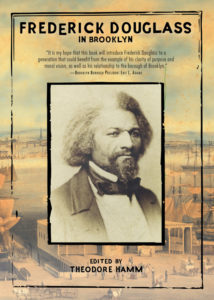The chair of SJC Brooklyn’s journalism and new media studies department had his latest book, “Frederick Douglass in Brooklyn,” profiled in in the Bookshelf section of The New York Times.
Theodore Hamm, Ph.D., “persuasively and passionately makes the case that the borough (and former city) became a powerful forum for Douglass’s abolitionist agenda in the mid-19th century after he escaped slavery in 1838,” New York Times writer Sam Roberts wrote.

For this work, Hamm compiled original source material to illustrate the complex relationship between Frederick Douglass and the city of Brooklyn. Most prominent are the speeches the abolitionist gave at the Brooklyn Academy of Music, Plymouth Church, and other leading Brooklyn institutions. Whether discussing the politics of the Civil War or recounting his relationships with Abraham Lincoln and John Brown, Douglass’ towering voice sounds anything but dated.
To provide a frame of contextual reference, Hamm provides an introductory essay examining the intricate ties between Douglass and Brooklyn abolitionists, while brief chapter introductions and annotations fill in the remaining historical context.
“It was gratifying to see Ted’s book cited in The New York Times and to discover that the reviewer found it as enjoyable as I did,” said Michael Hanophy, Ph.D., interim executive dean and professor of biology at SJC Brooklyn. “Interdisciplinary, insightful, and with a hyper-local focus, the book reminds me a great deal of the journalism and new media department that Ted leads here at SJC Brooklyn.”

SJC Brooklyn’s Theodore Hamm, Ph.D., with students.
Hamm writes about criminal justice and New York City politics for a number of publications, including the Village Voice, In Justice Today, The Daily Beast and City Limits. From 2000 to 2013, he was the editor of the Brooklyn Rail. He is the author of “Pieces of a Decade: Brooklyn Rail Nonfiction, 2000-2010,” “The New Blue Media: How Michael Moore, MoveOn, Jon Stewart and Company Are Transforming Progressive Politics.” and “Rebel and a Cause: Caryl Chessman and the Politics of the Death Penalty in Postwar California, 1948-1974.”

